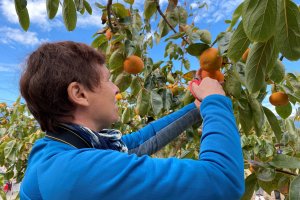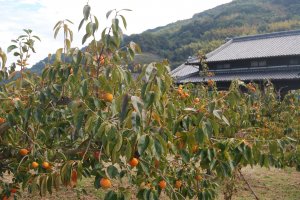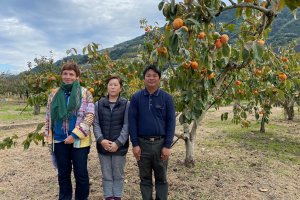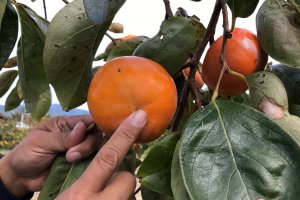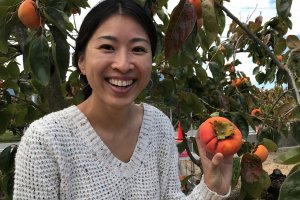The Katsuragi area is famous for growing persimmon (kaki). This area is located around the mountain of the same name, Mount Katsuragi, which is partly located in Wakayama Prefecture and partly in Nara Prefecture.
We visited the Hayashi family who owns Hayashi Noen, a kaki farm in Terao Village of Katsuragi Town, Wakayama Prefecture, to learn all about persimmon (kaki) and also to pick some.

The Hayashi family orchard
Their orchard is quite small and their persimmon trees are fairly “young” compared to the neighbors. They have only 60 trees on their land and these trees are only 20 years old.
Actually, Mr. Hahashi used to be a company worker before and he took over the orchard only 15 years ago from his father who had been a kaki orchard owner for most part of his life. With a smile on his face Mr. Hayashi said that he finally joined his brother and sister and other elders who are also engaged in kaki growing.
Amongst the trees on his farms are different varieties of kaki. Mr. Hayashi names them in order of the harvest time of their fruits, namely Gokuwase, the early harvest type, which is followed by Tonowase, Nakataniwase and Hiratamewase. Fuyu Kaki is harvested last, namely in the beginning of winter. These names are different in each region but these are the Katsuragi area names. Harvest season is from the beginning of October until early December.

The kaki annual cycle
Taking care of the persimmon trees is a year-long effort, say the Hayashi’s. Spring and autumn are key seasons for the farmers. In April and May when kaki trees are blossoming the farmers pick some of the flowers in order to reduce the fruits per tree later.
In September and October they clean the ground around the trees and add fertilizer. November and December is the main harvest season when the kaki farmers are at their busiest.
After the kaki trees have shed their leaves, the brightly orange colored persimmon fruits decorate the bare branches like balls on a Christmas tree. This is a pretty late autumn sight in Japan’s countryside.
To fill the kaki low season with some work, the Hayashi’s started to grow other fruit trees too. They have a few momo, peach trees, and they harvest the fruits in June and July, just when there is a bit of slack time in the kaki cycle.
They also grow mikan, the satsuma, and ume, the Japanese apricot plum, which keeps them busy throughout the year.

Picking kaki
The kaki trees are not very tall and they have horizontal branches which makes the kaki harvest relatively easy. One can just stand by the tree and pick the fruits, or use a ladder to climb up to the higher branches.
With many delicious-looking persimmon all around, we found it difficult to know which fruits to pick. Mr. Hayashi told us the secrete how to select: you have to look at the fruits from the top. If there are still shades of green, then they are not ripe yet and it is too early to pick them. You have to look for a reddish color which is an indication that the fruits are ripe and taste their best.
Groups can sign up to pick kaki for an hour at the Hayashi orchard. In return for “helping” with the harvest, you can take two packs of persimmon home. And there is persimmon tabehodai! You can eat as many kaki as you can stomach while sitting in a make-shift tent right on the orchard.



Usage of persimmon
Kaki fruits are used in a variety of ways. They are delicious when eaten fresh as dessert. Alternatively, they can be dried in order to keep them for the winter. They can also be made into jams and used in cakes and other dishes.
The Hayashi family uses persimmon in sandwiches, salads and in curries.
When we asked Mr. Hayashi for his favorite way of eating kaki, he revealed his secret persimmon snack: combine pieces of juicy and sweet persimmon with fresh ham and top it with some sprinkles of olive oil and black pepper.
The Hayashi's eat a lot of kaki each year but they still love kaki, Mr. Hayashi says smiling and he adds that persimmon fruits are said to have medicinal properties and can thus contribute to healing a number of ailments. So, eating a lot of kaki is good for your health!

Note:
This fruit picking activity is available from late October to December 5. A reservations is necessary!


